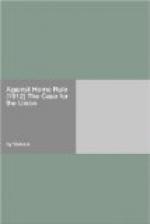Some of the provisions of this scheme are of exceptional interest. If it had ever been in operation the plan, for example, of adjusting the payments from one exchequer to the other in the event of changes being enacted by the Imperial Parliament in the Excise duties must have been fruitful of difficulties and created much friction. If the duties had been reduced there might have been an increased consumption. Who can say how much of the revenue lost to the Irish Exchequer in the event of a reduction of duties would have been due to the reduced rates of duty, and how much had been regained by increased consumption. Again, if the Excise duties had been increased, as in the Budget of 1909, to such a degree that the total revenue at the higher duty was less than the total revenue from the lower duty, who could have determined whether this was a case requiring a payment from the Irish to the British Exchequer, or from the British to the Irish Exchequer.
Perhaps the most striking novelty of the first scheme of 1893 was the retention of the Customs duties in lieu of Ireland’s contribution to Imperial Services. At that time the estimated value of the Customs contributed by Ireland was L2,400,000, and seeing that in 1886 her reasonable share of liability on account of Imperial Services was put at L4,600,000, the very large gift to Ireland represented by this scheme may be readily imagined. Even with the full advantage of this gift the estimated Irish surplus was put at L500,000. During the discussions of the Bill an error in the Excise contributions, reducing the revenue available to the Irish Exchequer by L356,000 was discovered. The reduced surplus of L144,000 was regarded by Mr. Gladstone as “cutting it too fine,” and the financial scheme was completely recast. Before explaining the third scheme it might be well to examine as before how the original scheme of 1893 would work out at the present time. This is shown in the following balance sheet.
SCHEME B (BASED ON BILL OF 1893, AS INTRODUCED).
REVENUE. L EXPENDITURE. L
1. Excise (true revenue 1.
Civil Government
ex.
licences) 2,952,000 charges (ex. Constabulary
2. Local Taxes—
and Lord
(a)
Stamps 333,000 Lieutenant’s salary)
6,952,000
(b)
Death Duties 914,000 2. Collection of Ireland
(c)
Income Tax 1,307,000 Revenues, etc.
298,000
(d)
Excise licences 284,000 3. Postal Services
1,404,000
3. Postal Revenue 1,155,000 4.
Contribution to Constabulary
4. Miscellaneous 150,000 (2/3rds
of
---------
L1,464,500) 976,000
7,095,000
Deficit 2,535,000
---------
---------
9,630,000
9,630,000




